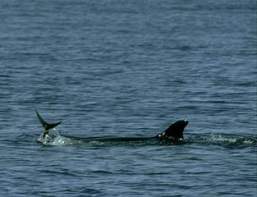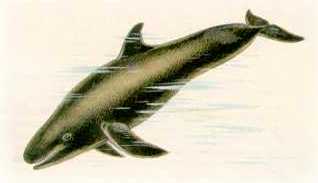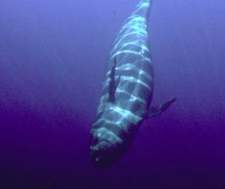9870 St Vincent Place, Glasgow, DC 45 Fr 45.
Семейство: Delphinidae Gray, 1821 = Дельфиновые

Семейство: Delphinidae Gray, 1821 = Дельфиновые
Род: Pseudorca Reinhardt, 1862 = Малые [чёрные] косатки
Вид: МАЛАЯ или ЧЕРНАЯ КОСАТКА - Pseudorca crassidens
Род Pseudorca = Малые [чёрные] косатки
МАЛАЯ или ЧЕРНАЯ КОСАТКА - Pseudorca crassidens
Довольно крупный дельфин длиной до 6 м и весом до 1,5 т.. Тело имеет черную окраску, спинной плавник небольшой. Биология изучена крайне плохо. Известно, что дельфины держатся небольшими группами. Основу питания по-видимому составляют стайные рыбы. Предпочтение отдают умеренным и теплым водам.
http://www.fegi.ru/PRIMORYE/SEA/mle17.htm
 Род Pseudorca Reinhardt, 1862 = Малые [чёрные] косатки
Род Pseudorca Reinhardt, 1862 = Малые [чёрные] косатки
МАЛАЯ или ЧЕРНАЯ КОСАТКА - Pseudorca crassidens
Pseudorca crassidens
СТАТУС. Малоизученные виды (IV категория)
Ареал обитания Вид, заходящий в территориальные воды России окраиной своего ареала, где популяция малочисленна и ее состояние трудно оценить. Внесен в Красную книгу СССР. Длина тела 365-600 см.
Распространение. В водах России малая косатка обитает только в акватории вокруг южной части Курильской гряды; возможны редкие заходы в Японское и Балтийское моря (1 - 4).
Общий ареал вида включает умеренные и теплые воды земного шара: в Атлантическом океане - от Северного и Балтийского морей и Северной Каролины до Южной Африки и Огненной Земли (1, 2); в Тихом океане - от штата Вашингтон и Курильских островов до Австралии, Тасмании, берегов Чили; в Индийском океане - от Персидского и Бенгальского заливов до зоны умеренных вод (1, 2, 6). В некоторых районах Мирового океана малая косатка встречается во все месяцы года, например в Средиземном море - Кадисском заливе (6). Миграции изучены слабо, видимо, не имеют строгой регулярности, хотя и совершаются иногда на дальние расстояния. Случалось, что малые косатки следовали за тунцеловными лодками на расстояние более тысячи миль (4).
Численность. В смежных с нашими водах малая косатка очень обычна в районе о. Кюсю, менее обычна - с южной и восточной стороны о. Хонсю и редка у о. Хоккайдо (5) . Численность вида в водах России не установлена.
Лимитирующие факторы. Малая косатка, как правило, не живет в водах с температурой ниже 15'С (на поверхности моря), но не исключена возможность ее редких заходов и в более холодные воды. Во время своих перемещений м  алая косатка чаще других китообразных обсыхает на суше, иногда большими стадами (от единичных особей до нескольких сотен); в наибольшем стаде, обсохшем в Аргентине на пляже местечка Мар-дель-Плата, погибло 835 особей (2). Причины обсыханий не ясны.
алая косатка чаще других китообразных обсыхает на суше, иногда большими стадами (от единичных особей до нескольких сотен); в наибольшем стаде, обсохшем в Аргентине на пляже местечка Мар-дель-Плата, погибло 835 особей (2). Причины обсыханий не ясны.
Пища малой косатки состоит из рыбы и головоногих моллюсков, в погоне за которыми малая косатка приближается к берегам (1, 2, 7). Половая зрелость самок наступает при длине тела 366 - 427 см. Единственный детеныш родится длиной 180 - 190 см (1, 2). Количество самцов и самок в стадах примерно одинаково. Между полами существует сильная привязанность, способствующая массовым обсыханиям. В неволе отмечено межродовое спаривание самки малой косатки с самцом гринды (7).
Специального промысла малой косатки не существует, лов бывает случайный, попутный с другими видами, а также для океанариев США и Японии (1, 8) . 30 - 50 животных ежегодно попадает в тунцеловные сети японских рыбаков в Тихом океане (8).
Малые косатки годами содержатся в крупных дельфинариях и океанариях США и Японии (2, 9, 10).
Болезни не изучены. Найдены два вида гельминтов: один - круглые черви, другой - скребни (1, 2).
Меры охраны. Необходим контроль с целью предотвращения случайной или попутной добычи малых косаток.
http://nature.ok.ru/doc/mammal/1_44.htm

Pseudorca crassidens (Owen, 1846)
1. Description
False killer whales are large members of the delphinid family, adult males reaching 6 m, while adult females reach 5 m in length. The skull is similar to that of Orcinus orca, but the two species don't seem to be closely related. The colour is largely black or dark grey, with a white blaze on the ventral side between the flippers. The head is rounded, the body shape elongate, the dorsal fin falcate and positioned in the middle of the back. In males, the melon protrudes further forward than in females (Baird, 2002)
Kitchener et al. (1990) found substantial differences in cranial characters between false killer whales from Australia, Scotland, and South Africa, but recognition of any subspecies would be premature (Rice, 1998).
2. Distribution
P. crassidens is found world-wide in tropical and temperate waters. It ranges north to Maryland, Scotland, southern Japan, Hawaii, and British Columbia and south to Chubut in Argentina, Cape Province, Western Australia, South Australia, Tasmania, South Island of New Zealand, Chatham Islands, and Concepcion, Chile (Rice, 1998).
The false killer whale is widely distributed, though not really abundant anywhere (Carwardine, 1995) and generally does not range beyond 50° latitude on either hemisphere (Jefferson et al. 1993). Most of the distributional records and many of the data available for the species are the result of strandings (Odell and McClune, 1999). In the South Pacific, the distributional area may have to be extended further wet than indicated on the map, based on sightings by Aguayo et al. (1998) between Chile and Easter Islands (112°W and 91°W). There are numerous records of animals seen in cool temperate waters, although these appear to be outside the normal range. Wanderers have been recorded as far afield as Norway and Alaska (Carwardine, 1995).
Distribution of Pseudorca crassidens: tropical, subtropical and warm temperate waters, mainly offshore (mod. from Odell and McClune 1999;
Notarbartolo di Sciara, 2002; © CMS / GROMS).
3. Population size
There is no estimate of world-wide abundance. Population estimates of 16,000 have been reported for the coastal waters of China and Japan (Odell and McClune, 1999 and refs. therein).
4. Biology and Behaviour
Habitat: P. crassidens is mainly seen in deep, offshore waters (and some semi-enclosed seas such as the Red Sea and the Mediterranean) and sometimes in deep coastal waters. It seems to prefer warmer temperatures (Carwardine, 1995). Off Hawaii, both shallow (less than 200m) and deep water (greater than 2000 m) habitats have been reported for the species. Pseudorca appears to be relatively common off the Japanese coast. With the exception of sightings from the eastern tropical Pacific, data on distribution are lacking for most oceanic areas (Odell and McClune, 1999, and refs. therein).
Behaviour: The False Killer Whale readily approaches boats and is an exceptionally active and playful animal, especially for its large size (Carwardine, 1995).
Schooling: Sightings of groups of 10 - 20 individuals are common and group sizes as high as 300 have been reported, presumably forming when food is abundant. Herd size in recent mass strandings ranged from 28 to over 1000 animals, and a mean herd size of 55 has been reported from Japanese waters. Mass stranded herds have about equal numbers of males and females of various sizes. False killer whales may associate with other species, e.g. bottlenose dolphins and other small cetaceans, possibly indicating shared or overlapping feeding grounds (Odell and McClune, 1999).
Reproduction: No seasonality in breeding is known for the false killer whale (Jefferson et al. 1993).
Food: Although false killer whales eat primarily fish and cephalopods, they also have been known to attack small cetaceans and, on one occasion, even a humpback whale (Jefferson et al. 1993). Depending on location, stomach contents included salmon (Oncorhynchus sp.), squid (Berryteuthis magister or Gonatopsis borealis) sciaenid and carangid fishes, bonito (Sarda sp.), mahi mahi or dolphin-fish (Goryphaena), yellowfin tuna (Thunnus albacares), yellowtail (Pseudosciana spp.) and perch (Lateolabrax japonicus), mackerel, herring and smelt (Odell and Miller McClune, 1999, and refs. therein). Koen-Alonso et al. (1999) examined the stomachs of false killer whales from both coasts of the Strait of Magellan, Chile. The most important prey were the oceanic and neritic-oceanic squids, Martialia hyadesi and Illex argentinus, followed by the neritic fish, Macruronus magellanicus. The prey species were subantarctic, with two Antarctic species, abundant over the Patagonian shelf and adjacent oceanic waters around Tierra del Fuego. There are reports that Pseudorca fed on and chased other dolphins in the eastern tropical Pacific during chase and backdown operations of tuna purse seine fishing, a habit that has also been attributed to the pygmy killer whale, Feresa attenuata (Odell and McClune, 1999, and refs. therein).
5. Migration
Migration is not well documented, although it has been suggested that closely related globicephalid whales including Globicephala, Pseudorca and Grampus species in the western North Pacific move from warmer, southern waters in winter to cooler, northern waters in summer. Apparent seasonal movements in the western North Pacific may be related to prey distribution. False killer whales have been seen travelling in line formation and one large herd of about 300 individuals was distributed over an area several miles long and half a mile wide. Reported travelling speeds are 3-6 knots and as high as 10 knots (Odell and McClune, 1999, and refs. therein).
6. Threats
Direct catch: Pseudorca are occasionally taken in Japan for food and in St. Vincent Island, Caribbean for meat and cooking oil (Jefferson et al. 1993; Odell and McClune, 1999).
Incidental catch: Incidental take of small numbers of false killer whales in gill nets has occurred off northern Australia, the Andaman Islands, the southern coasts of Brazil and in tuna purse seines in the eastern tropical Pacific. Dolphin entrapment in tuna purse seine nets may be providing artificial feeding opportunities for Pseudorca on other marine mammals (Odell and McClune, 1999). Yang et al. (1999) report on by-catch rates in Chinese coastal fisheries (trawl, gill and stow net) which may number in the hundreds per year for P. crassidens alone.
Killing: The largest documented fisheries interaction is in the waters around Iki Island, Japan, where over 900 false killer whales were killed in drive fisheries from 1965 to 1980 in an attempt to reduce interactions with the yellowtail (Pseudosciaena spp.) fishery (Jefferson et al. 1993; Odell and McClune, 1999).
Pollution: High levels of pesticides (DDE) and heavy metals (mercury) were detected in stranded specimens and one individual had the remains of a plastic jug in its stomach (Odell and McClune, 1999 and refs. therein)..
http://www.cms.int/reports/small_cetaceans/data/P_crassidens/p_crassidens.htm
